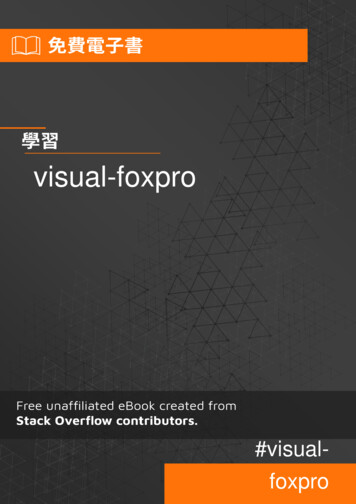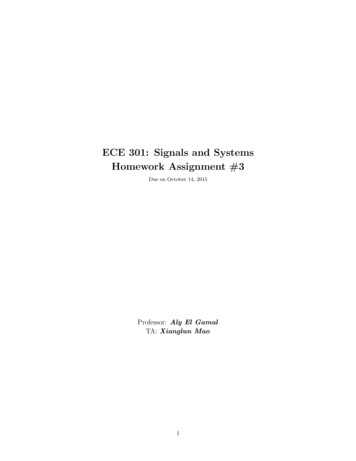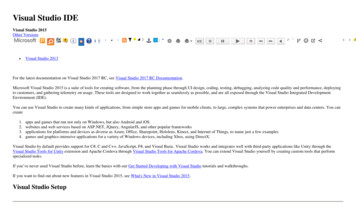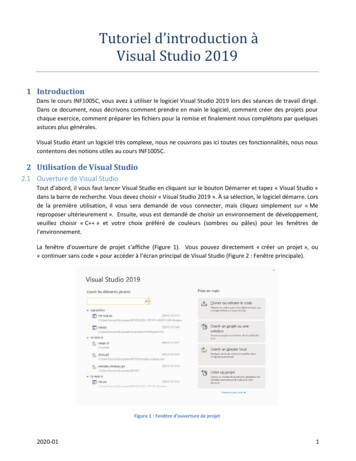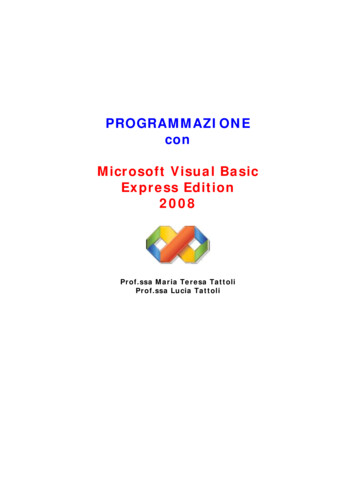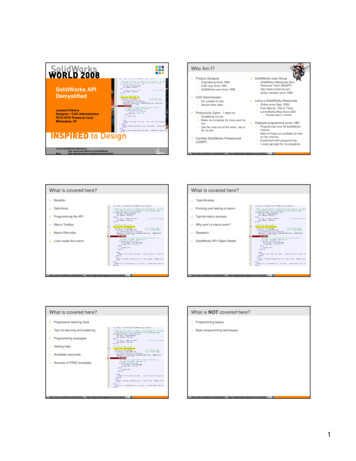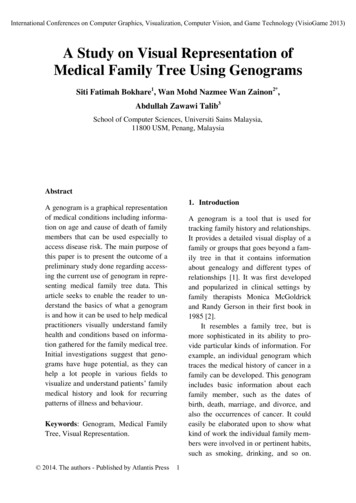
Transcription
International Conferences on Computer Graphics, Visualization, Computer Vision, and Game Technology (VisioGame 2013)A Study on Visual Representation ofMedical Family Tree Using GenogramsSiti Fatimah Bokhare1, Wan Mohd Nazmee Wan Zainon2*,Abdullah Zawawi Talib3School of Computer Sciences, Universiti Sains Malaysia,11800 USM, Penang, MalaysiaAbstract1. IntroductionA genogram is a graphical representationof medical conditions including information on age and cause of death of familymembers that can be used especially toaccess disease risk. The main purpose ofthis paper is to present the outcome of apreliminary study done regarding accessing the current use of genogram in representing medical family tree data. Thisarticle seeks to enable the reader to understand the basics of what a genogramis and how it can be used to help medicalpractitioners visually understand familyhealth and conditions based on information gathered for the family medical tree.Initial investigations suggest that genograms have huge potential, as they canhelp a lot people in various fields tovisualize and understand patients’ familymedical history and look for recurringpatterns of illness and behaviour.A genogram is a tool that is used fortracking family history and relationships.It provides a detailed visual display of afamily or groups that goes beyond a family tree in that it contains informationabout genealogy and different types ofrelationships [1]. It was first developedand popularized in clinical settings byfamily therapists Monica McGoldrickand Randy Gerson in their first book in1985 [2].It resembles a family tree, but ismore sophisticated in its ability to provide particular kinds of information. Forexample, an individual genogram whichtraces the medical history of cancer in afamily can be developed. This genogramincludes basic information about eachfamily member, such as the dates ofbirth, death, marriage, and divorce, andalso the occurrences of cancer. It couldeasily be elaborated upon to show whatkind of work the individual family members were involved in or pertinent habits,such as smoking, drinking, and so on.Keywords: Genogram, Medical FamilyTree, Visual Representation. 2014. The authors - Published by Atlantis Press1
When pertinent details are included,the genogram can help clarify and provide some understanding of how cancerhas impacted this particular family.Genograms can contain a lot of information on the families they represent.First, they contain basic data found infamily trees such as name, gender, dateof birth, and date of death of each individual. Additional data such as education, occupation, major life events,chronic illnesses, social behaviors, nature of family relationships, emotionalrelationships, and social relationshipsmay also be included. Some genogramsmay also include information on disorders running in the family such as alcoholism, depression, diseases, alliances,and living situations.Genograms can vary significantly,because there is no limitation as to whattype of data can be included [4]. Fig. 1shows some basic symbols for genogram.Based on the visual representationusing the symbols in Fig. 1, informationabout individuals such as gender, age,death, sexual orientation, income, ethnicorigin and immigration pattern can bemade available to assist health practitioners.A genogram using medical symbolsin as depicted in Fig. 1 may be useful intherapy to record patterns of illness oraddiction in individuals and betweenfamily members, from which a familytherapist can perform an assessment regarding interventions to assist the family.Fig. 1. Standard Symbols for Genograms [1].2
What can a genogram tell us?based on feedback and developments inthe field, reflecting the growing andwidespread use of genograms [1]. Twofurther editions of the book have beenpublished to reflect these modifications.The new book point out that genogramsare a work in progress, particularly asthinking about family context evolves.Technology is also evolving; for example, computerised programs are able torepresent very complex genogram formats.Development of various types ofgenogram such as cultural, socioeconomic, ethical and career/work genograms is further evidence of the development and broader use of the tool overtime [3].Genograms have been used for thelast four decades as a tool for mappingfamily patterns and the psychologicalfactors that interrupt relationships. Theyallow a practitioner to identify and understand repetitive patterns of behaviourand to recognise hereditary tendencies;hence genograms are popular withhealthcare professionals in areas such associal work, psychology, psychiatry, genealogy, genetic research, education andmany more fields. Other informationmay be contained in a genogram depending on the desired information; for example, if the purpose of a genogram is tomap the medical history of a family, thegenogram might include informationsuch as hereditary patterns, genetics andpsychological patterns. Clinical uses ofgenograms include gaining insight intoclients’ psyche [5] and as a data gathering device on individuals and families[6].1. It can show patterns of householdstructure. Does the family have ahistory of strong nuclear families? Ofdivorce and remarriage? Of multigenerational households?2. It can show life cycle patterns. Howdid family members move throughthe stages of leaving home, marrying,having children, and so on?3. It can show patterns repeated acrossgenerations. Is there any indicationof family strife between siblings? Alcoholism or other substance abuse?Strong expectations of success? Greatemphasis on education or a particularline of work? Individual memberscutting themselves off from the family?4. It can show critical life events whichhave a profound effect on the family. Have there been prolonged illnesses? Suicide? Untimely deaths?Lottery winnings?5. It can show relational patterns. Hasthere been a history of close motherdaughter relationships? Of fracturedfather-son relationships? Of siblingrivalry? Close relationships with nonfamily members?2. Background & Related WorkSince the publication of MonicaMcGoldrick and Randy Gerson's firstbook in 1985, the genogram and its symbols have been expanded and modified3
Use of the genogram in family studies and family therapy is based on theassumption that some basic patterns between mother, father, and children, arereplicas of past generations and may wellbe repeated in future generations. Theserepeated patterns may include relationship factors, personality characteristics,specific illnesses, etc. For example, onefamily may be typified by female-headedhouseholds over several generations.Another family may have many members with exceptional musical talent. Athird family may have a history of diabetes. Such pieces of information are easilyand simply illustrated in genograms.tailed reports containing analysis of theinformation stored in each person’s individual properties. Commercial software,such as Genome Analytic, is available toproduce genograms, as well as hundredsof different academic and scientific programs for specialized use.3.1. Creating a Medical GenogramTo create a medical genogram, usersmust first determine which genetic diseases they wish to include. Options include: heart disease, cancer, diabetes,Alzheimer’s disease, thyroid disease,certain birth defects, alcoholism, depression and schizophrenia. Users can always add more diseases later or changethe symbols to reflect their currentneeds. Fig. 2 shows an example of ascreenshot taken from Genepro [7].In this diagram, the color and thecorner of the fill associated with the selected disease need to be selected. In thiscase, heart disease is represented by ared square in the top left corner. Usermay use any combination of colors within the individual gender sign to makeeach disease unique. They can alsochange the color of the symbol or thetext to represent a health condition.3. Creating and Developing GenogramsGenograms are created through the gathering of information, which is essentiallyfamily members telling their story. Thedrawing of the genogram conforms to aset of rules in order that users all havethe same understanding and, therefore,attain a similar interpretation of thegenogram.A clinician can gain multiple viewsby interviewing multiple family members, and they should scan for patternsthat are repeated, helping families toavoid repeating unfortunate patterns ortransmitting them into the future.Genograms can help to visualizecomplex interactions between individuals and to study patterns of behaviors ordiseases. Genograms are easily createdwith genealogy software, as advancedsoftware allows the user to include tremendous amounts of data. Genealogysoftware also allows users to create de-Fig. 2. Example of Genepro Screenshot [7].4
through several generations. Our family'sgenogram may reveal an inclination tostrike out on one's own, or perhaps reveal a pattern of family disruptions dueto divorce, siblings cutting themselvesoff from family members, or health problems. Genograms can also reveal positive patterns. Many family historiesshow a pattern of strong, close nuclearfamilies, siblings working well together,and forebears living long and satisfyingretirements.Based on the information described,genograms have a fundamental use infamily therapy. They can function as aguide to provide a family with a betterunderstanding of their history, dynamicsand situations. Also. this visualizationtool allows social transformation andempowerment as well as being sensibleto the diverse type of families.A genogram can also be used to understand one's development and the forces that converged to shape them. In thewords of Monica McGoldrick, andRandy Gerson, "One might compare thefamily process to music, in which themeaning of individual notes depends ontheir rhythms in conjunction with eachother and with the memories of pastmelodies and the anticipation of thoseyet to come" [3]. When an individual isable to evaluate an aspect of their ownperson in concert with the broader context of family patterns, a much deeperunderstanding can be achieved.3.2. Example of a Medical GenogramFig.3. shows an example of a medicalgenogram created for three generation.Based on this diagram, we can see thatPaul, a smoker, recently died of a heartattack after years of battling with heartdisease and diabetes. His wife Karen hasbeen diagnosed with breast cancer.Nathalie is pregnant, and she is worriedthat she may have a breast tumour. Theanxiety she feels has affected her mentalhealth, and she is also dealing with depression. Meanwhile, Andrew is also asmoker, and his 8-year-old son hasDown syndrome.Fig. 3. Example of medical genogram4. Discussion & Future WorkOnce the users are familiar with the different colour codes that have been created, they will be able to read genogramsin a matter of seconds, be able to understand the family risks for certain diseases, and come up with strategies forscreening, diagnosis, and management.One of the great values of a genogram is that it can bring to light certainpatterns that have repeated themselvesAcknowledgments. We thank UniversitiSains Malaysia (USM) for providing thefunding (Research University (RUI)Grant - no: 1001/PKOMP/817071)through which this article was produced.5
[6] Shellenberger, S., Dent, MM., Davissmith, M., Seale, JP., Weintraut, R.,Wright, T. (2007). Cultural Genogram: A Tool for Teaching and Practice. Families Systems & Health 25(4), pp. 367-381.[7] Genepro-Geneology Software, available from: http://www.genopro.com/(2013).[8] Belous, C. K., Timm, T., Chee, G.,& Whitehead, M. (2012) Revisitingthe sexual genogram. AmericanJournal of Family Therapy, 40(4),pp.281-296.[9] Frame, M.W. (2000). The spiritualgenogram in family therapy. Journalof Marital and Family Therapy, 26, pp. 211–216.References[1] Kennedy V, (2010), Genograms,Mai review, (3) pp. 1 - 12.[2] McGoldrick,M. & Gerson,R.,(1985) Genograms in family assessment, New York : W.W. Norton.[3] McGoldrick, M., Gerson, R., &Petry SS. (2008) Genograms: Assessment and intervention, (3rd Edition) New York : W.W. Norton.[4] Butler, J. (2008). "The Family Diagram and Genogram: Comparisonsand Contrasts". American Journal ofFamily Therapy. 12 36 (3) pp.169–180.[5] Wachtel, E.F. (1982). The familypsyche over three generations: Thegenogram revisited. Journal of Marital and Family Therapy, 8, 334–343.6
widespread use of genograms [1]. Two further editions of the book have been published to reflect these modifications. The new book point out that genograms are a work in progress, particularly as thinking about family context evolves. Technology is also evolving; for exam-ple, computerised programs are able to
